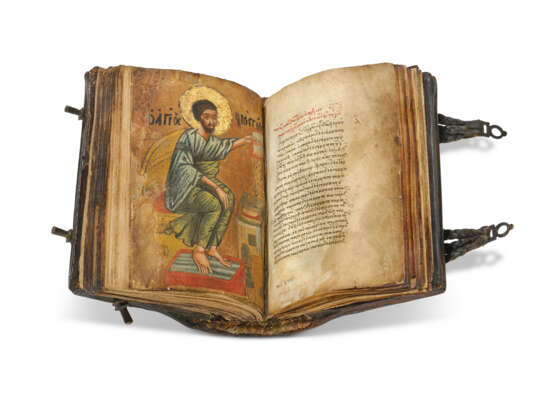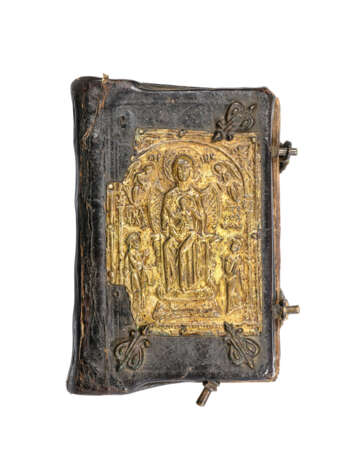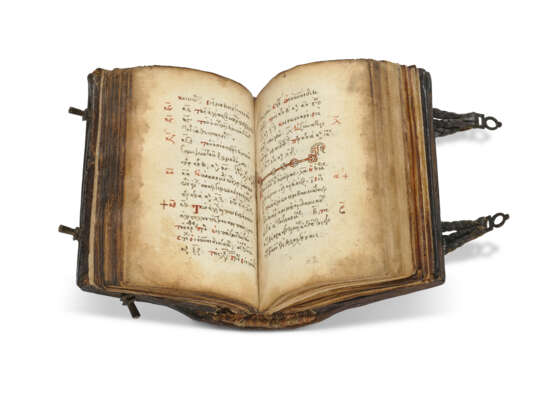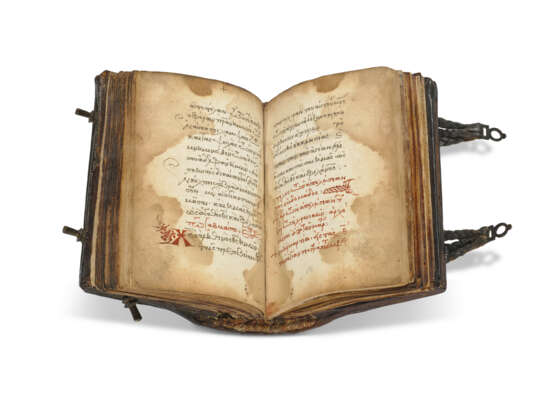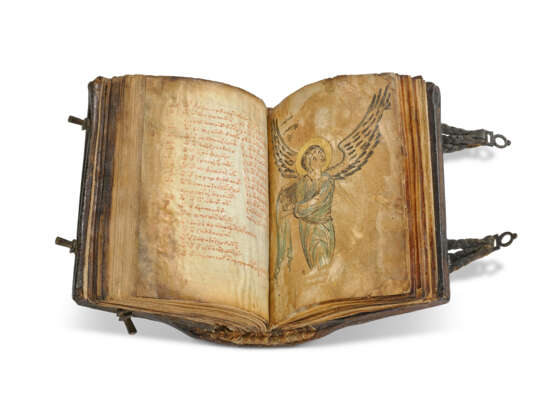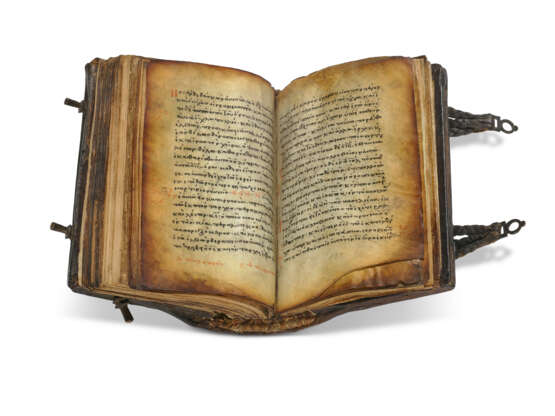ID 1214875
Lot 11 | Jankos of Kobatzi's Gospel of Matthew
Estimate value
£ 40 000 – 60 000
Calendar of Service forms, Apoluses, and the Gospel of St Matthew, in Greek, illuminated manuscript on paper and vellum [?Serbia, 12th and 16th centuries]
An early compendium of medieval Greek religious texts: a 12th-century Gospel of Matthew and early 16th-century Calendar of Service forms and Apoluses compiled and bound in 1543/4 by the Serbian priest Jankos of Kobatzi. In its contemporary, 'alla greca' binding. Formerly in the collections of Sir Joseph Radcliff, Bt.
140 x 90mm. 126 leaves, a compilation of three texts of which the first two are 16th century and on paper (see below) and the third is 12th century and on vellum, as follows: Calendar of Service forms and Apoluses: 93 leaves, complete, collation: 13, 2-166, modern foliation 1-93 followed here, 14-15 long lines written in a Greek minuscule in black ink, the Apoluses possibly by a different scribe, initials, rubrics, and decorated line-endings in red, knotted or foliate panel headpieces, gathering signatures survive, the watermarks of the first text identical to Piccard XVII, 1571 (Madrid, 1541), those of the second very close to Piccard XII, 1726 (Ravenna, 1510); a fragment from the Gospel of Matthew, 33 leaves, collation: 13, 27, 310, 46 (including f.116a), 58, modern foliation 94-126 followed here (f.116a between ff.116 and 117), 20 lines written in a small regular Greek minuscule, rubrics, marginal references and initials in red, preceded by an index in red and a scrolling, single-line headpiece delimited by two lilies in black with red detailing on f.94, two full-page miniatures of an angel with a book on f.95 and St Matthew writing on f.95v, introductory leaf in a later, 16th-century, more square Greek minuscule on f.96 (reinforced repair on first bifolium, page-edges smoke-blackened, some marginal staining, ff.95-96 are 16th-century replacements on paper, holes and losses repaired with extensive loss of text on ff.112-120).
Binding:
16th-century binding, possibly Serbian c.1544, brown leather over wooden boards, sewn on 3 stations, spine raised 'alla greca', on upper cover a ?15th-century gilt brass panel showing the Virgin and Child enthroned with 2 flying angels and 2 standing male saints, all beneath a decorated arcade, in Byzantine style, fastened with 4 lily-formed bronze fastening pins (upper-left lily fastening pin missing, rebacked with lower cover renewed). Fitted box.
Provenance:
(1) Jankos, priest of Kobatzi, Serbia, 1543/4. A colophon on f.73v states that the present texts were renewed and brought up to date by Jankos, priest of Kobatzi in the year A.M. 7052, 2nd indict (1543/4 CE). The form of his name and the place-name (Kovadzi means 'smith' in Serbian) suggest a 16th-century provenance in Serbia.
(2) Sir Joseph Radcliffe, Bt (1744-1819), Rudding Park, England: his armorial bookplate on inside upper cover.
(3) Sotheby's, 11 November 1990, lot 3, sold for £3,400 to:
(4) The Schøyen Collection, MS 694.
Content:
Blank f.1; Readings and forms of service through the church year ff.2-73v; Colophon and anathema from Jankos, priest of Kobatzi, f.73v; blanks, ff.74-75; Apoluses, the concluding words of the service from Sunday morning to Saturday evening ff.76-92v; blank f.93; the pinax (table of contents) to the Gospels of Saint Matthew f.94; two full-page miniatures of an angel and Saint Matthew and an introduction to the Gospels of Saint Matthew, ff.95-96; Gospels of Saint Matthew, 1:1-13:46 with capitula ff.97-126v.
The fragment of the Gospel of Matthew (1:1-13:46) is registered as Aland, 2836, text category 5 (Byzantine recension). It is an example of a very rare script-type, for which Michael Welte from the Institut für Neutestamentliche Textforschung at the Westfälische Wilhelms-Universität in Münster could find no comparables. The form of the breathings nonetheless shows that this section was written in the 12th century. There is also a pinax – a table of contents – in red ink on the first page (ff.94-95v), and marginal annotations to the Gospels throughout the text in red ink that help to find the appropriate reading given in the pinax. The miniatures are later additions.
The rest of the manuscript consists of a collation of readings and forms of service for the months, days, and times of day for the year and an Apoluses – the concluding words of the service – from Sunday morning to Saturday evening. The watermarks also support an unrelated composition for these two religious texts: ff.1-75 is written on paper which is identical to Piccard XVII, 1571 (Madrid, 1541); the Apoluses on the other hand is on paper with marks much closer to Piccard XII, 1726 (Ravenna, 1510). Both texts date to the early 16th-century and were brought together sometime later in the 16th century, plausibly by Jankos, priest of Kobatzi (?Serbia), whose colophon on f.73v, in yet a different hand, claims that it was he who collated and updated the texts in c.1543/4 CE. Whether or not it was Jankos who bound the entire manuscript, his following anathema makes sure to guard against any future reassembly of or tampering with his compilation: 'he who takes away from this here will have the curse of all the angels upon him and will have the 4 Evangelists as his enemies'. Remarkably, this manuscript has survived intact in its 16th-century 'alla-greca' binding, still guarding the manuscript from any future repurposing across the centuries. Kobatzi's curse remains in effect.
| Auction house category: | Medieval & renaissance manuscripts, Books and manuscripts |
|---|
| Auction house category: | Medieval & renaissance manuscripts, Books and manuscripts |
|---|
| Address of auction |
CHRISTIE'S 8 King Street, St. James's SW1Y 6QT London United Kingdom | |
|---|---|---|
| Preview |
| |
| Phone | +44 (0)20 7839 9060 | |
| Buyer Premium | see on Website | |
| Conditions of purchase | Conditions of purchase |
